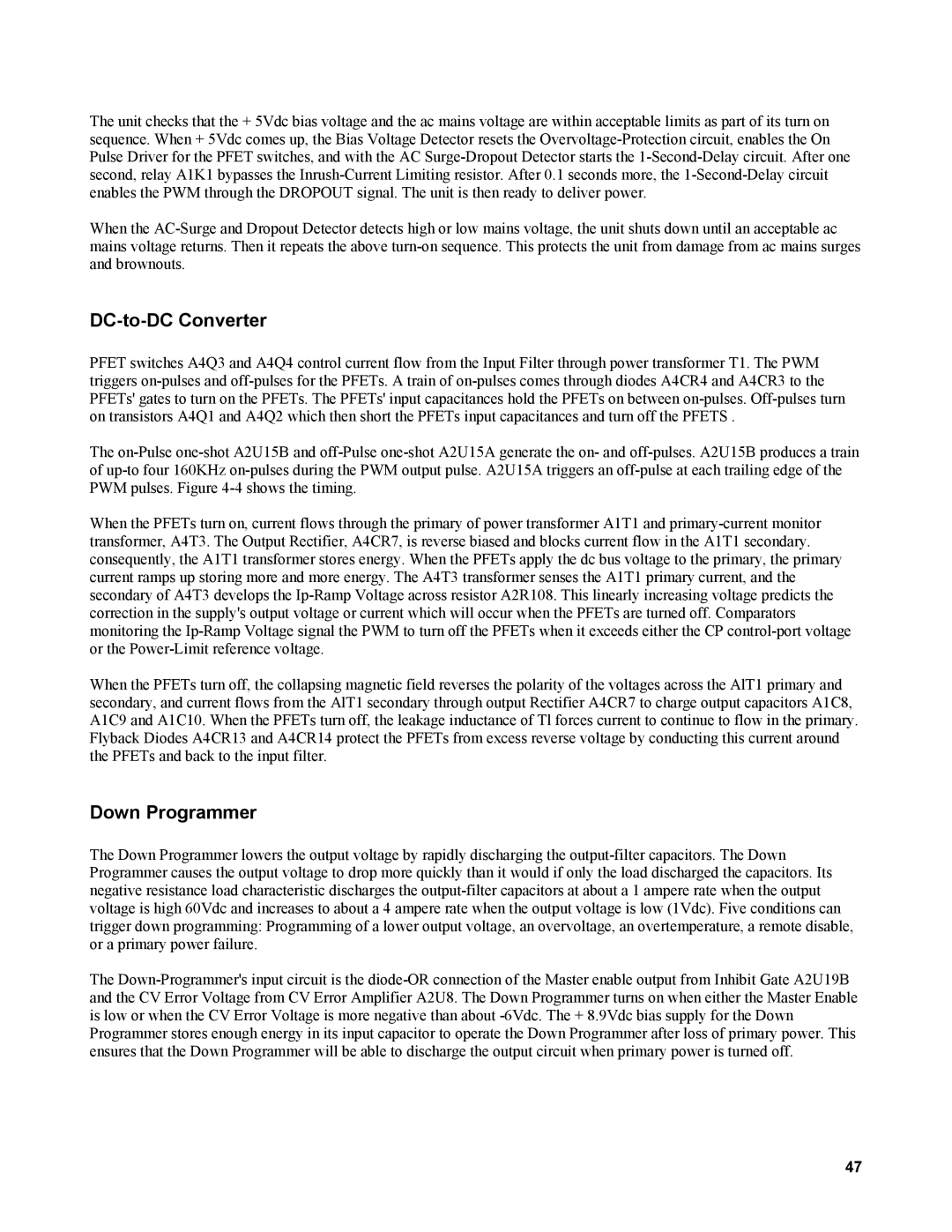The unit checks that the + 5Vdc bias voltage and the ac mains voltage are within acceptable limits as part of its turn on sequence. When + 5Vdc comes up, the Bias Voltage Detector resets the Overvoltage-Protection circuit, enables the On Pulse Driver for the PFET switches, and with the AC Surge-Dropout Detector starts the 1-Second-Delay circuit. After one second, relay A1K1 bypasses the Inrush-Current Limiting resistor. After 0.1 seconds more, the 1-Second-Delay circuit enables the PWM through the DROPOUT signal. The unit is then ready to deliver power.
When the AC-Surge and Dropout Detector detects high or low mains voltage, the unit shuts down until an acceptable ac mains voltage returns. Then it repeats the above turn-on sequence. This protects the unit from damage from ac mains surges and brownouts.
DC-to-DC Converter
PFET switches A4Q3 and A4Q4 control current flow from the Input Filter through power transformer T1. The PWM triggers on-pulses and off-pulses for the PFETs. A train of on-pulses comes through diodes A4CR4 and A4CR3 to the PFETs' gates to turn on the PFETs. The PFETs' input capacitances hold the PFETs on between on-pulses. Off-pulses turn on transistors A4Q1 and A4Q2 which then short the PFETs input capacitances and turn off the PFETS .
The on-Pulse one-shot A2U15B and off-Pulse one-shot A2U15A generate the on- and off-pulses. A2U15B produces a train of up-to four 160KHz on-pulses during the PWM output pulse. A2U15A triggers an off-pulse at each trailing edge of the PWM pulses. Figure 4-4 shows the timing.
When the PFETs turn on, current flows through the primary of power transformer A1T1 and primary-current monitor transformer, A4T3. The Output Rectifier, A4CR7, is reverse biased and blocks current flow in the A1T1 secondary. consequently, the A1T1 transformer stores energy. When the PFETs apply the dc bus voltage to the primary, the primary current ramps up storing more and more energy. The A4T3 transformer senses the A1T1 primary current, and the secondary of A4T3 develops the Ip-Ramp Voltage across resistor A2R108. This linearly increasing voltage predicts the correction in the supply's output voltage or current which will occur when the PFETs are turned off. Comparators monitoring the Ip-Ramp Voltage signal the PWM to turn off the PFETs when it exceeds either the CP control-port voltage or the Power-Limit reference voltage.
When the PFETs turn off, the collapsing magnetic field reverses the polarity of the voltages across the AlT1 primary and secondary, and current flows from the AlT1 secondary through output Rectifier A4CR7 to charge output capacitors A1C8, A1C9 and A1C10. When the PFETs turn off, the leakage inductance of Tl forces current to continue to flow in the primary. Flyback Diodes A4CR13 and A4CR14 protect the PFETs from excess reverse voltage by conducting this current around the PFETs and back to the input filter.
Down Programmer
The Down Programmer lowers the output voltage by rapidly discharging the output-filter capacitors. The Down Programmer causes the output voltage to drop more quickly than it would if only the load discharged the capacitors. Its negative resistance load characteristic discharges the output-filter capacitors at about a 1 ampere rate when the output voltage is high 60Vdc and increases to about a 4 ampere rate when the output voltage is low (1Vdc). Five conditions can trigger down programming: Programming of a lower output voltage, an overvoltage, an overtemperature, a remote disable, or a primary power failure.
The Down-Programmer's input circuit is the diode-OR connection of the Master enable output from Inhibit Gate A2U19B and the CV Error Voltage from CV Error Amplifier A2U8. The Down Programmer turns on when either the Master Enable is low or when the CV Error Voltage is more negative than about -6Vdc. The + 8.9Vdc bias supply for the Down Programmer stores enough energy in its input capacitor to operate the Down Programmer after loss of primary power. This ensures that the Down Programmer will be able to discharge the output circuit when primary power is turned off.
